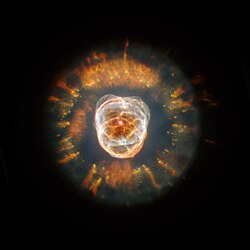Eskimo Nebula
| Nebula | |
|---|---|
 NGC 2392, the Eskimo Nebula by HST. | |
| Observation data: J2000 epoch | |
| Right ascension | 07h 29m 10.7669s[1] |
| Declination | +20° 54′ 42.488″[1] |
| Distance | ≥2,870 ly (≥880 pc)[2] ly |
| Apparent magnitude (V) | 10.1[1] |
| Apparent dimensions (V) | 48″ × 48″[3] |
| Constellation | Gemini |
| Physical characteristics | |
| Radius | ≥0.34 ly[a] ly |
| Absolute magnitude (V) | ≤0.4 [b] |
| Notable features | – |
| Designations | NGC 2392,[1] Caldwell 39, Clown Nebula,[1] Clown Face[1] |
The Eskimo Nebula (NGC 2392), also known as the Clownface Nebula[4] or Caldwell 39, is a bipolar[2] double-shell[5] planetary nebula (PN). It was discovered by astronomer William Herschel in 1787. The formation resembles a person's head surrounded by a parka hood. It is surrounded by gas that composed the outer layers of a Sun-like star. The visible inner filaments are ejected by a strong wind of particles from the central star. The outer disk contains unusual light-year-long filaments.

NGC 2392 lies more than 2,870 light-years away and is visible with a small telescope (but more preferably with a larger telescope) in the constellation of Gemini.
Historic data
The nebula was discovered by William Herschel on January 17, 1787, in Slough, England. He described it as "A star 9th magnitude with a pretty bright middle, nebulosity equally dispersed all around. A very remarkable phenomenon."[6] NGC 2392 WH IV-45 is included in the Astronomical League's Herschel 400 observing program.
See also
Notes
References
- ^ a b c d e f "SIMBAD Astronomical Database". Results for Eskimo Nebula. Retrieved 2006-12-22.
- ^ a b O'dell, C. R.; Balick, B.; Hajian, A. R.; Henney, W. J.; et al. (2003). "Knots in Planetary Nebulae". Winds, Bubbles, and Explosions: a conference to honor John Dyson, Pátzcuaro, Michoacán, México, September 9–13, 2002 (Eds. S. J. Arthur & W. J. Henney) Revista Mexicana de Astronomía y Astrofísica (Serie de Conferencias) (http://www.astroscu.unam.mx/~rmaa/). 15: 29–33. Bibcode:2003RMxAC..15...29O.
{{cite journal}}: External link in|journal= - ^ O'Dell, C. R.; Balick, B.; Hajian, A. R.; Henney, W. J.; et al. (2002). "Knots in Nearby Planetary Nebulae". The Astronomical Journal. 123 (6): 3329–3347. Bibcode:2002AJ....123.3329O. doi:10.1086/340726.
- ^ Windows to the Universe
- ^ Guerrero, M. A.; Chu, Y.-H.; Gruendl, R. A.; Meixner, M. (2005). "XMM-Newton detection of hot gas in the Eskimo Nebula: Shocked stellar wind or collimated outflows?". Astronomy and Astrophysics. 430 (3): L69–L72. arXiv:astro-ph/0412540. Bibcode:2005A&A...430L..69G. doi:10.1051/0004-6361:200400131.
- ^ The Scientific Papers of Sir William Herschel by J. L. E. Dreyer, Royal Society, London 1912
External links
- APOD (2003-12-07) – NGC 2392: The Eskimo Nebula
- The Eskimo Nebula on WikiSky: DSS2, SDSS, GALEX, IRAS, Hydrogen α, X-Ray, Astrophoto, Sky Map, Articles and images
